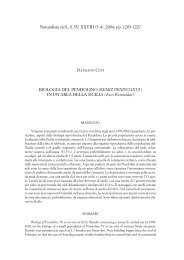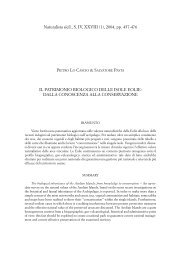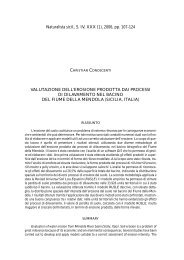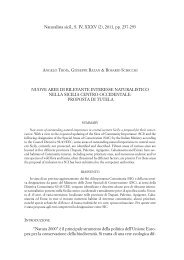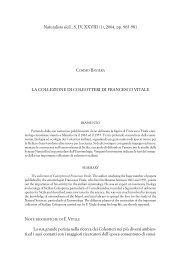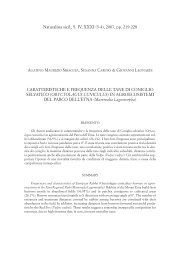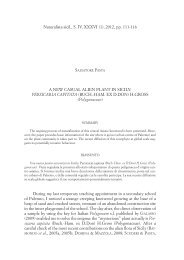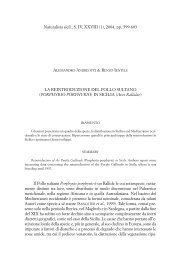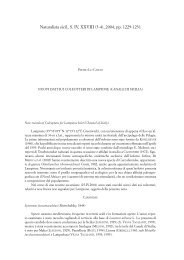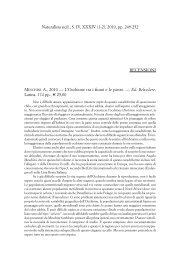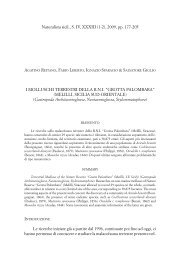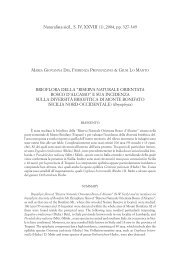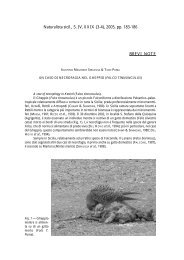Il Ruolo delle aree protette siciliane nella conservazione del ... - sssn.it
Il Ruolo delle aree protette siciliane nella conservazione del ... - sssn.it
Il Ruolo delle aree protette siciliane nella conservazione del ... - sssn.it
- No tags were found...
You also want an ePaper? Increase the reach of your titles
YUMPU automatically turns print PDFs into web optimized ePapers that Google loves.
356 TOMMASO LA MANTIA, SALVATORE PASTA & GIUSEPPE BARBERAcontinua tabella 1Taxon Presenza/distribuzione; Presenza Presenzatendenza demografica; di studi all’internoprincipali minacce sulla di <strong>aree</strong>variabil<strong>it</strong>à <strong>protette</strong>e/o pSICPinus halepensis Miller L; D (popolamenti autoctoni) and I NO TT(impianti artificiali ed <strong>aree</strong> marginali):rischio d’inquinamento geneticoPinus laricio Loudon subsp. L; D: disturbo <strong>del</strong>l’hab<strong>it</strong>at, cambiamenti SI TTcalabrica Cesca et Peruzzi nelle pratiche selvicolturali,rischio d’inquinamento geneticocon Pinus nigra s.l., attacchi parass<strong>it</strong>ariPinus pinaster Solander subsp. L; DD: cambiamenti nell’uso <strong>del</strong> suolo, SI TThamiltonii (Ten.)disturbo <strong>del</strong>l’hab<strong>it</strong>atHuguet <strong>del</strong> VillarPinus pinea L. L; DD (popolamenti r<strong>it</strong>enuti autoctoni) NO TPe I (impianti artificiali): cambiamentinell’uso <strong>del</strong> suolo, rischiod’inquinamento geneticoPistacia lentiscus L. ( 2 ) MC; I: rischio d’inquinamento genetico NO TPPistacia terebinthus L. ( 2 ) C; S (D nelle <strong>aree</strong> agricole) NO TPPlatanus orientalis L. (Di) L; D: disturbo <strong>del</strong>l’hab<strong>it</strong>at, NO TTrischio d’inquinamento genetico,attacchi parass<strong>it</strong>ariPopulus alba L. C; S: disturbo <strong>del</strong>l’hab<strong>it</strong>at NO TPPopulus nigra L. MC; S: disturbo <strong>del</strong>l’hab<strong>it</strong>at, NO TPrischio d’inquinamento geneticoPopulus tremula L. R; DD: effetto-serra NO TTPrunus mahaleb L. 2 R; DD: disturbo <strong>del</strong>l’hab<strong>it</strong>at, NO TPdifficoltà riproduttive ( 1 )Pyrus pyraster (L.) Du Roi L; DD: cambiamenti nell’uso <strong>del</strong> suolo NO TPe altre forme selvatiche<strong>del</strong> ciclo di Pyrus communis L.Pyrus spinosa Forsskål MC; I: cambiamenti nell’uso <strong>del</strong> suolo NO TP(incl. Pyrus amygdaliformis)Quercus amplifolia Guss. C; D: disturbo <strong>del</strong>l’hab<strong>it</strong>at, SI TPdifficoltà riproduttive ( 1 ),rischio d’inquinamento genetico,oak decline syndromeQuercus cerris L. L; D: effetto-serra, disturbo <strong>del</strong>l’hab<strong>it</strong>at, SI TPattacchi parass<strong>it</strong>ari,difficoltà riproduttive ( 1 )Quercus coccifera L. s.l. R; D: cambiamenti nell’uso <strong>del</strong> suolo, SI TP(incl. Quercus calliprinos Webb) difficoltà riproduttive ( 1 )Quercus congesta C. Presl L; DD: disturbo <strong>del</strong>l’hab<strong>it</strong>at, ( 3 ) TPrischio d’inquinamento genetico,oak decline syndromesegue tabella 1



